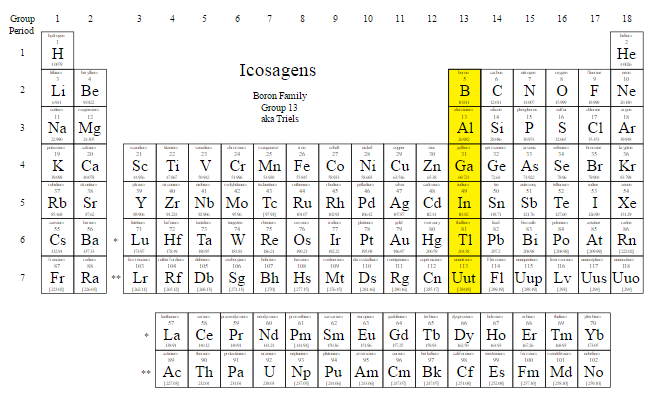Group 13 of p-block is called the boron family. Group 13 or the boron family consists of 6 known elements and one chemically uncharacterized element. Here are the elements-boron-B, aluminium-Al, gallium-Ga, indium-In, and thallium-Tl and also the chemically uncharacterized nihonium-Nh.
- All the elements of group 13 are soft except boron. Except for boron, which is classified as a non-metal, all other elements of this group are metals. All the elements are reactive at the moderate temperature while born is reactive only at the high temperatures.
- Aluminium is metal but shows many similarities with boron(non-metal) and gallium, indium, thallium almost exclusively metallic in character. Aluminium is the most common element in the earth’s crust(8.3%). It is also a very important element of this group because of its various industrial uses.
- These elements also have been called as the triels. Group 13 elements also have been referred as icosagens because of the icosahedral structures formed by these elements. All the elements of the group have three electrons in their valance cell. They can lose three electrons to achieve a noble gas configuration, hence mostly shows the +3 oxidation state.
- Boron occurs sparsely because of the bombardment by the subatomic particles produced from natural radioactivity. Boron differs from other group members in its refractivity, hardness and reluctance to participate in the metallic bonding.
- Gallium is found in the earth in the abundance of around 13ppm, while indium is the 61st most abundant element found in earth’s crust and thallium found in a moderate amount throughout the earth.
- Nihonium is termed as a synthetic element because it is never found in nature.
- Several elements of group 13 have an important biological role in our ecosystem. Boron is essential for the plant but found in trace amount in humans. According to the latest study boron can bind to the carbohydrates so it is possible that it may have an important role in human systems, too.
- Boron’s deficiency in the plant can result in stunted growth of plants, reduced cell division, decreased production of leaf chlorophyll, deposition of lignin and suberin, lowering of stomatal conductance, etc. While an excess of boron can be also harmful by inhibiting the growth. Plants use boron for the strengthening of their cell walls.
- Aluminium is considered a safe element because it doesn’t have any biological role or any particular toxicity.
- Indium and gallium affect the metabolism hence the physiological process of our body. Gallium has the ability to bind itself to iron proteins that transport and store iron.
- Thallium is used as a pesticide and it is highly toxic for humans as it interferes with the activity of several vital enzymes in our body. Even a tiny dose of thallium can cause hair loss from all over the body, it causes many other symptoms sometimes eventually halting the functions of many organs. Murderers also use thallium because of its colorless, odorless and tasteless nature and therefore the use of thallium pesticides has been banned in the USA and many countries since 1957.
- Nihonium is a highly unstable element as it decays by emitting alpha particles. Due to this high radioactivity, it can be very harmful to both plants and humans.
